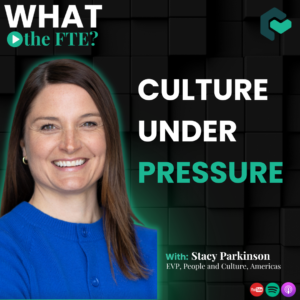Every HR leader eventually realises that pay is not just a transaction. It shapes how people see fairness inside a company. When reward systems lose clarity or consistency, trust weakens fast.
That is something global Total Rewards leader, Katy Hoszka, understands deeply. In her conversation with Maya Bellay on What the FTE?, Katy shared how fairness, transparency, and equity can transform the relationship between people and pay.
Reward Strategy Reflects Business Strategy
“Your reward strategy says everything about your business priorities,” Katy says.
She believes rewards should reinforce what an organisation values most. When goals are about accountability and performance, rewards should make that visible. “People can tell when your systems and your values do not match,” she explained.
According to Gartner, companies that align pay design with strategic goals outperform peers in productivity and retention. For Katy, this alignment is non-negotiable:
“Reward systems are a mirror. They show what a business truly values, not just what it says it values.”
The Case for Clarity and Cost Discipline
Fairness only works when people can see how decisions are made. And for senior leaders, that clarity must include cost. Katy’s approach is to translate HR recommendations into the language of the CFO.
“Executives care about impact, risk, and return,” she says. “When you connect people decisions to those outcomes, the conversation changes.”
That insight aligns with McKinsey research showing that HR leaders who quantify people outcomes in financial terms gain stronger board-level influence. It’s not about learning finance to please executives, Katy argued; it’s about earning credibility by speaking the same language.
She added that HR leaders must move beyond feel-good narratives.
“If you can show that a new benefit saves costs or mitigates risk, you’ll get faster buy-in. Numbers tell the story.”
Transparency Without Education Creates Noise
When pay transparency policies arrive, many companies rush to publish salary bands. Katy warns that this can backfire if leaders aren’t prepared to discuss them.
“Transparency only builds trust when leaders can explain what the numbers mean,” she says. “Otherwise, it just creates confusion.”
Harvard Business Review found that organisations training managers before introducing transparency see a 30 percent boost in employee confidence in fairness. Katy agrees.
“You can post a pay range in a day, but building understanding takes time and care.”
For her, pay transparency is less about disclosure and more about education. When leaders understand compensation philosophy, they can explain it confidently.
“If a manager doesn’t get it, how can an employee trust it?”
Fairness Means Equity, Not Equality
Asked how she defines fairness, Katy was clear. “Fairness doesn’t mean everyone gets the same. It means recognising contribution.”
Earlier in her career, she equated fairness with equality. Over time, she realised that true fairness means equity, rewarding the value each person creates. “If it’s your strategy to reward top performance, then sameness can’t be your goal.”
Deloitte’s 2025 Human Capital Trends calls this shift the “personalisation imperative.” Reward systems now need to adapt to performance and context rather than treating everyone identically. For HR leaders, that means designing systems flexible enough to recognise both impact and potential.
Katy added that reward systems also carry an emotional weight.
“Compensation tells people whether they’re valued. That’s why fairness isn’t a math problem. It’s a trust problem.”
Flexibility Is the Only Constant
When asked how to “future-proof” compensation, Katy didn’t hesitate. “You can’t,” she said. “The market changes too fast.”
Her advice to HR leaders is to think in cycles, not checkboxes. Review data regularly, listen to feedback, and adjust. The goal is not to design the perfect system, but to keep one that evolves with the business and the people in it.
According to Gartner, organisations with flexible pay structures outperform static ones in engagement and retention. Katy agrees:
“People’s needs shift. Market data shifts. So our systems need to shift too. Fairness isn’t fixed. It’s maintained.”
From Numbers to Narratives
For Katy, the evolution of Total Rewards isn’t about more complex spreadsheets. It’s about storytelling with integrity.
“Reward strategy is as much about narrative as numbers,” she explained. “It’s how you make the business understand that fairness and performance are not opposites – they’re partners.”
She encourages HR leaders to tell that story clearly. “The best compensation philosophy doesn’t live in a slide deck. It lives in every pay decision you make.”
Final Thought
If Katy had to summarise her philosophy, it would fit on a single note: “Equitable. Trust-driven. Performance-based. Human.”
Human, because pay affects people’s lives. Trust-driven, because transparency without context is empty. Performance-based, because contribution should matter. Equitable, because sameness isn’t fairness.
“Technology helps us analyse data, but fairness will always be a human decision.”
If you’d like to hear Katy unpack this in detail, listen to the full episode of What the FTE? below.
🎧 Listen Now:
—
Want more insights like this?
🔗 Browse the full catalogue of What the FTE? episodes
📩 Sign up for the weekly newsletter to get the good stuff straight to your inbox
P.S. Building a high-performance, remote-first team? Certn’s background checks won’t slow you down. 👉 Start screening in minutes—not weeks.





